People
‘People Often Get Hung Up on the Search for Meaning’: Artist Seth Price on Why You Probably Don’t Understand His Work
Price’s new show—his first in New York in six years—is on view now at the Petzel Gallery .
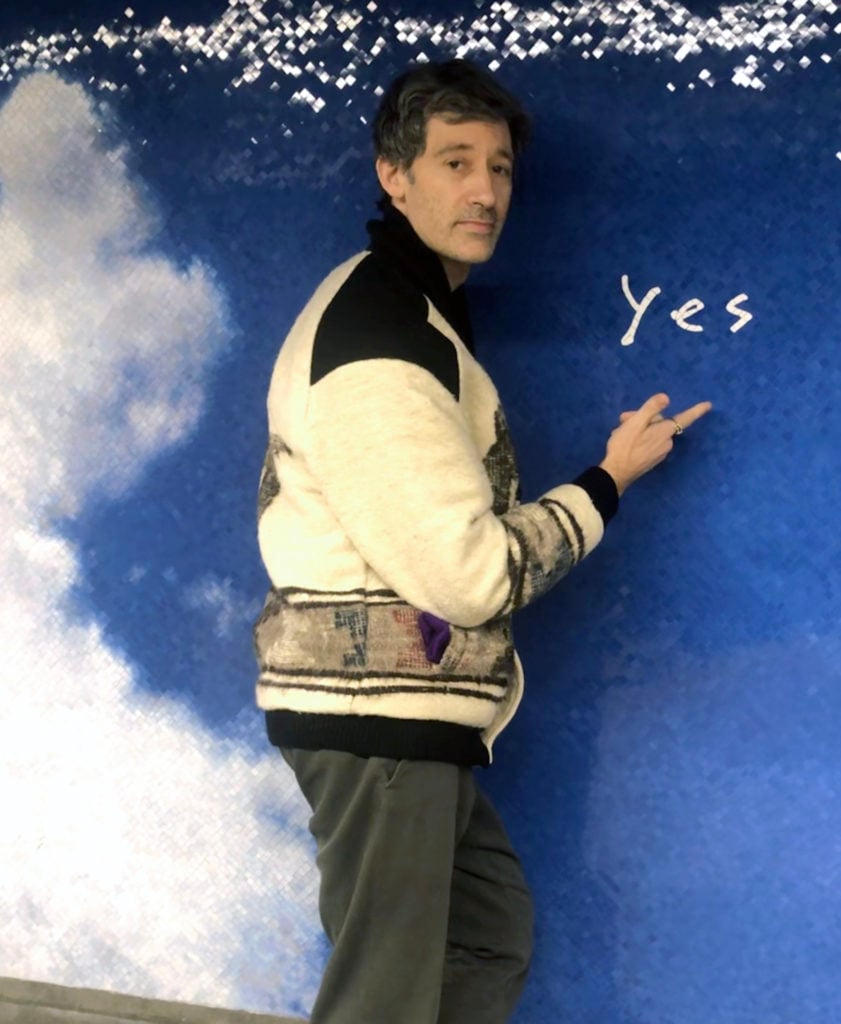
Price’s new show—his first in New York in six years—is on view now at the Petzel Gallery .

Taylor Dafoe

Seth Price is not an artist—or at least, he’s hesitant to adopt that title. It makes sense. The term “artist,” free though we think it is, actually refers to a very specific type of maker, one who often carves out a niche in an accepted medium. This doesn’t apply to Price. For one, he doesn’t operate within one form and instead bounces between mixed-media art, writing, music, and other arenas. For another, much of his work is about confronting these and other stingy art world conventions.
Price’s new show at Petzel Gallery, “Hell Has Everything,” is his first at the gallery in six years. In the center is a ceiling-mounted video, Social Synth (2017), that rolls through stitched-together images captured by a robotic camera scanning the skin of a squid. Nearby, a couple of fabric lightboxes depict a glitchy, unrecognizable patch of skin captured in a similar fashion. Meanwhile, in the back room, a row of mixed media panels—made from various combinations of printer ink, acrylic polymer, paint, plastic, glue, wood, and metal—come together in a corner. They depict what look like real, yet unidentifiable objects—like instruments from a foreign science.
These works are a long way from what Price advocated in “Dispersion,” his seminal essay about dematerializing art that first made Price a rising star in the early 2000s. Since then, he’s mounted shows all over the world and published dozens of books. He produced a fashion show for dOCUMENTA (13); was the subject of a yearlong research project, Seth Price is on our mind, at CCA Wattis in San Francisco; and had an ambitious mid-career retrospective at the Stedelijk Museum in Amsterdam (it also traveled to the Museum Brandhorst in Munich).
In 2016, Price published his first novel, “Fuck Seth Price.” Drolly dubbed a memoir, the story is told from the perspective of a mature artist who goes on a murderous spree whilst musing on the role of the art market and his own career.
“For better or for worse, everyone was in agreement that the market was the only indicator that mattered now,” the unnamed narrator states early on in the book, adding: “It was no longer necessary to deem a piece interesting, provocative, weird, or complex, and it was almost incomprehensible to hate something because you liked it, or like it because it unsettled you, or any of the other ambivalent and twisted ways that people wrestled with the intersection of feelings and aesthetics. You almost didn’t need words anymore: it was enough to say, ‘That painting is awesome,’ just as you’d say, ‘This spaghetti is awesome.’”
Ironically, when it comes to his own artwork, Price takes a similar stance, opting to let his material experiments speak for themselves. As such, his work can be hard to come to terms with. He’s having trouble coming to terms with it too. In fact, a certain ineffability is a prerequisite for a work leaving Price’s studio.
Sitting in a light-filled room above the Petzel gallery, Price spoke with artnet News about the importance of ambiguity, why artists should not have to defend their work, and why he’s more interested in materiality than ever before.
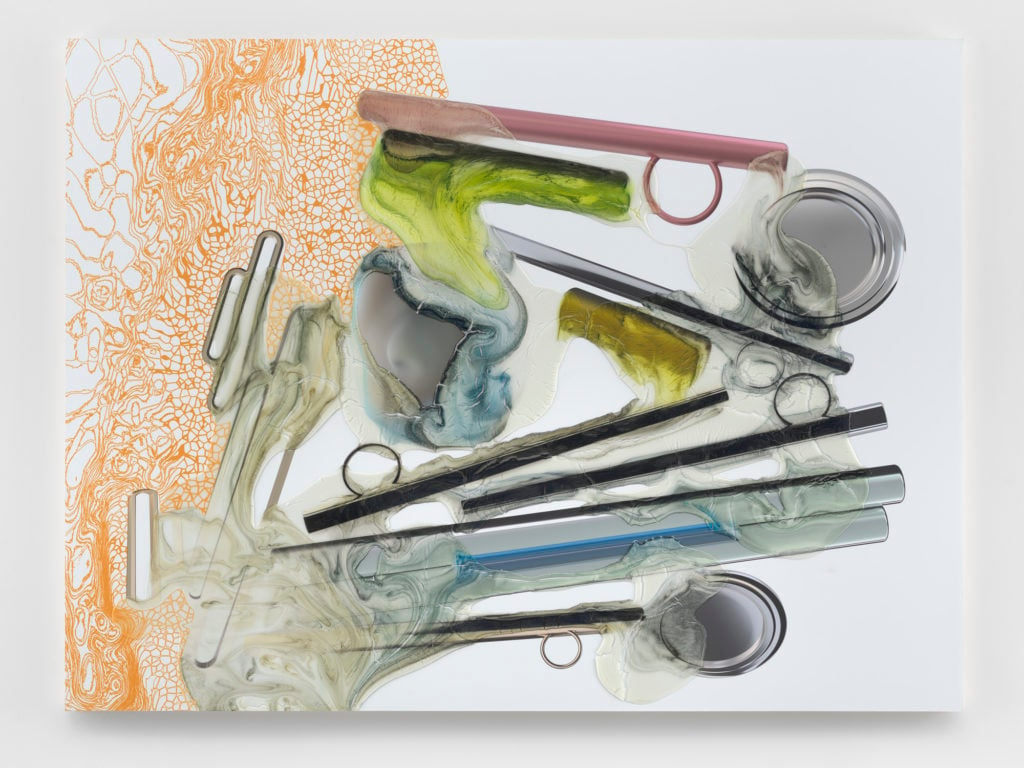
Seth Price, Hell Has Everything (2018). Courtesy of Petzel Gallery.
In the past, you’ve said that sometimes it can take several months or even years for you to appreciate the full value of your works and what they’re about. Is that the case with the works in this show?
Definitely.
What if, in five years, you realize it’s all terrible?
That happens. I’m not writing this stuff off yet, but there have been shows where I felt like, “What the hell was I doing? What a bad idea.”
How does that way of thinking inform your decision-making in the studio?
I try not to think about it too much. There’s a case to be made for art production as a way of not thinking.
That’s surprising to hear. Being familiar with your writing, I would have thought you would bring a more methodical, intellectualized approach to the studio.
Yeah, that approach is one of the things you can play with when the medium is language, or forms of writing. The problem is that writing travels a hundred times faster than material artwork, and it speaks a lot louder. If you write as an artist, it seems to offer a way for people to read all your other work, whether or not that even makes sense. People get the idea that there’s got to be some explanation for this sculpture, if they could just parse it.
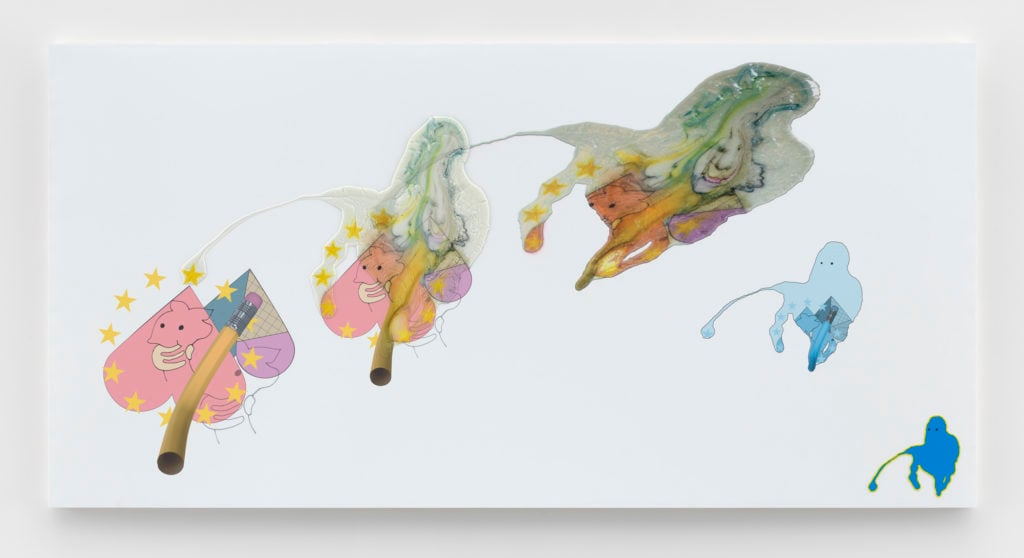
Seth Price, We’re going to need a smaller map (2018). Courtesy of Petzel Gallery.
So you’re in the studio and you have an idea for a piece. How do you turn that into a reality without over-intellectualizing it?
Well, I almost never have an idea for a piece. It’s usually more like a feeling or an image, and then I’m interested in different materials and processes, and experimenting with them, pushing them to see what happens. It’s pretty micro, it’s not macro. If I’m lucky, ideas kind of accrete during the process. Art can take those moments where the needle skips and make something interesting.
There are several instances of that in this particular show.
It’s basically all that.
I reread “Dispersion” recently. While that essay is still very salient, it struck me how distant it feels from your work now. Much of “Dispersion” was about the idea of dematerializing art; this show, like many of your shows in the last several years, is more about materiality and tactility and a one-on-one engagement with objects whose power comes from the unique conditions of their production.
That essay served a function of helping me move my focus from dematerialized work—video, writing, music—into materiality. It was a way of testing that for myself. Within a year of finishing the essay I was working on the calendar paintings, and the next year I was making vacuum forms and having my first solo show. The essay kind of precipitated that.
How much of those ideas laid out in “Dispersion” are still present in your thinking?
They’re present, but I can’t even read that thing. The last time I tried was years ago, and I couldn’t get through a word of it. It was like picking up an alien object. But that’s often the case with artists and older work. And people shouldn’t have to defend their own work.
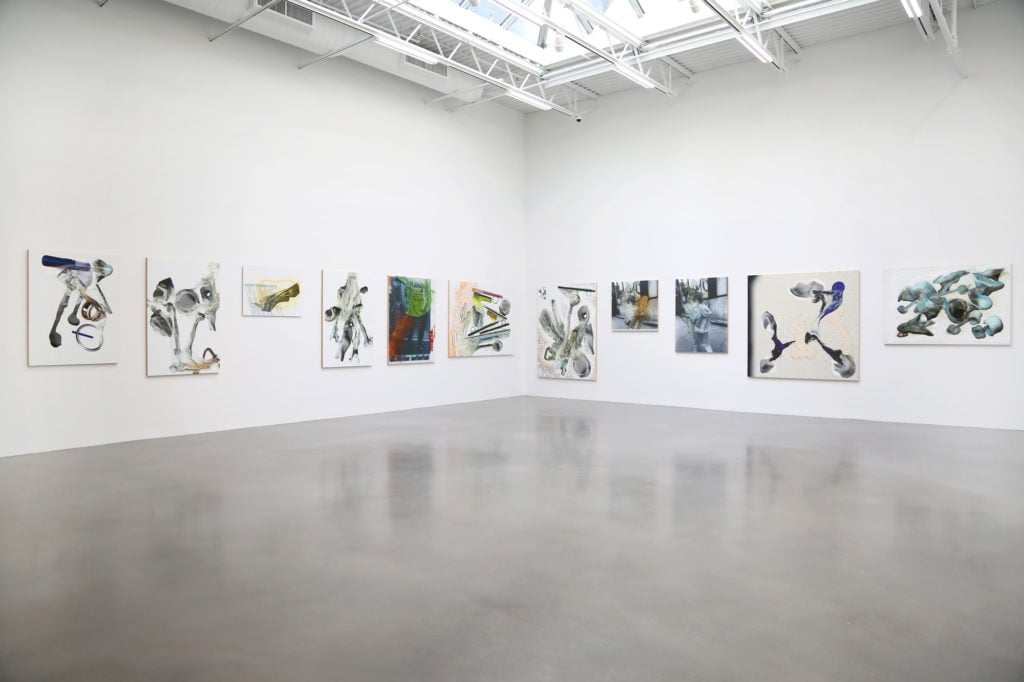
Installation view, “Hell Has Everything,” 2018. Courtesy of Petzel Gallery.
That makes sense—it was written some 16 years ago now. A lot of time has passed since then.
Media was different, culture was different. We’re still figuring out what happened to art in those first years of the century; no one knows yet. I look back at my works from then—”Dispersion,” and the pieces that made up my first show at Reena Spaulings—and they were made in the context of a particularly warlike culture. I suppose it’s like that now, but in a different way. There was a whiplash in going from the nineties and the turn of the century right into 9/11 and Afghanistan and Iraq. It was also before social media, which changed everything.
Social media is one of the reasons that “Dispersion” is still so relevant and complex for me today. It was prescient in that sense, foregrounding as it did the power of sharing.
You could say it was prescient, but the wave of social media crashes over so much of that early internet discourse and makes it totally obsolete. Right now it’s humiliating to even have to say the phrase “the Internet.” I think it’s because social media finished digging the grave and putting the last bits of dirt on the Internet.
Several of the works in this exhibition—such as Social Synth (2017) and both untitled lightboxes—were created with 3D modeling and map-making software. What is it about those tools that interests you?
I hesitate to get too far into thinking about the tech, because it was a means to an end. It’s too easy to spin off into musings about the implications of data-mining and Google maps. The 3D modeling software, too: it’s just been about making these photographic images.
You consider them to be photographic?
I consider them to be as much in dialogue with photography as with painting or printmaking or collage. I think people who aren’t so familiar with CGI don’t even know they’re looking at an invented object. Again, I didn’t want it to be work that was about tools. It was more about, “How can we create something where you don’t know what the content of the image is, and you don’t know how it was made?”
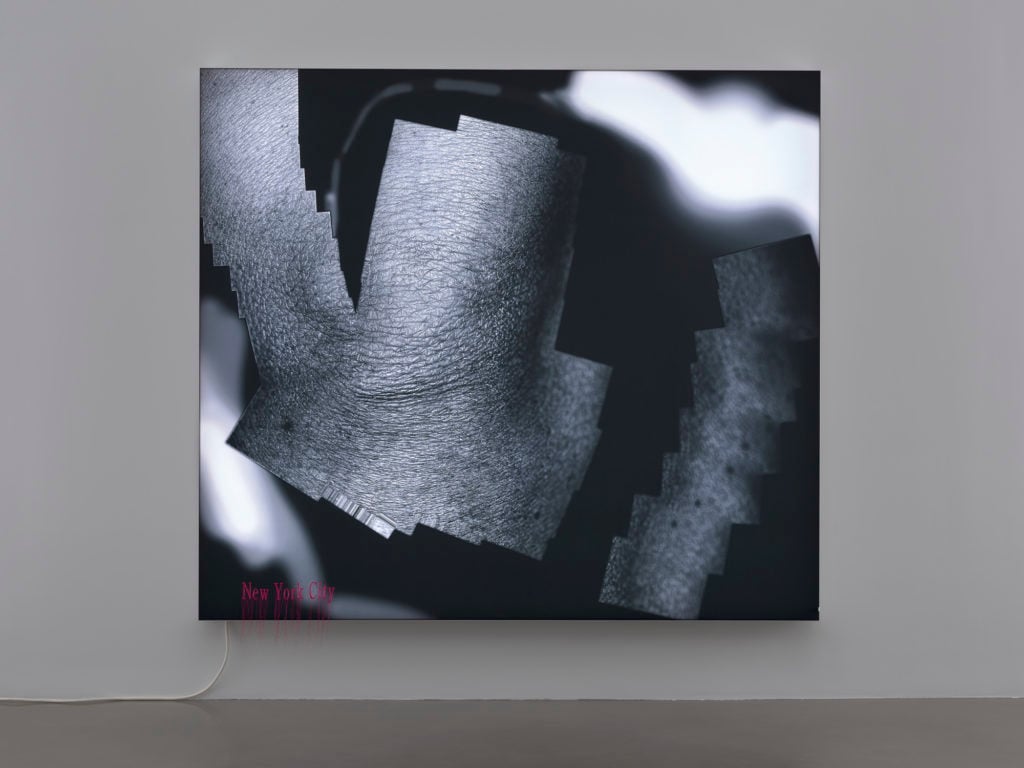
Seth Price, Untitled (2015–18). Courtesy of Petzel Gallery.
What about the embroidered “New York City” at the bottom of the lightboxes? I’m not sure what do with that.
[Laughs] It started as a material exploration. I’ve been making these lightboxes for a few years now, and they’re printed on fabric, but that was never clear—people thought they were plastic. That is, historically, what lightboxes are made of; the fabric is just a newer way of making them. But it made me think, “What can I do with the fabric that’s specific to fabric? I can embroider it.”
I was also thinking about fashion and clothing. Words are really important in fashion right now. There was a time when they weren’t; there was a no-logo moment, but now we’re way into language, from couture down to streetwear and knock-offs. There’s tourist merch I see every day that says “New York City,” but you also might see a Balenciaga shirt that says “Paris.” I wanted to play with that, and really brand the artworks. After I did it, I realized it was kind of the same impulse I had when I would put the production dates on the calendar paintings and the vacuum forms. There’s something interesting about the naked fact of production. “New York City” makes a certain sense because that’s where the pieces are made, so it’s a way of putting real information into the work. But even as it gives you that, it takes it away, because it’s not clear what you’re supposed to do with that information.
I imagine there’s a real tendency for viewers to approach these works through thinking about how they were made, to enter them through the lens of technology or materials. Why is it that you’re resistant to that?
I’ve never wanted labor and processes to be visible, and I don’t like works that need a lot of explanation. Ideally the piece would be its own little world, even if you’re not sure what it is, or how you feel about it. On the other hand, I’m aware that people often attach a lot of explanation to my work. I think that happens sometimes when a work produces an ambiguous feeling: people generate discourse to try to make sense of the feeling. Maybe not in the case of abstract painting, where it’s understood that you can bathe in uncertainty and a balance between knowing and not knowing. But as soon as you step into other kinds of work, and especially when the work takes up media and culture, people reach for discourse.
The M.O. of painting is one that we’re familiar with; we’re comfortable with its irresolvability. Is that what attracted you to experiment with the medium?
One of the things that made me interested in stepping into that domain was that I wanted these works to be taken for what they were within the frame. That’s something that painting grants you. I don’t really consider them paintings, but I understand why they’re referred to that way.
It took me a while to understand the attraction of painting. When I was working my way through some of that stuff that became “Dispersion,” I wasn’t interested in painting at all. Becoming friends with painters changed all that. I feel like it’s easy to have a conversation about the things I’m interested in with painters. It cuts through all the bullshit. At this point it’s a lot harder for me to talk to, say, somebody who’s interested in the more discursive side of art production. That’s something I’m interested in, in a general sense, but when it comes to my own work, people often get hung up on the search for meaning.
That’s surprising to hear. From my perspective, the discursive side of art is one you’re very much in conversation with.
Well, what is that even, the “discursive side of art”? I mean, I love it, and I hate it. For a lot of people there’s a “good” politics, where there’s only one job, which is to expose ideology. I often think my works are pretty dumb, but in a way that interests me.
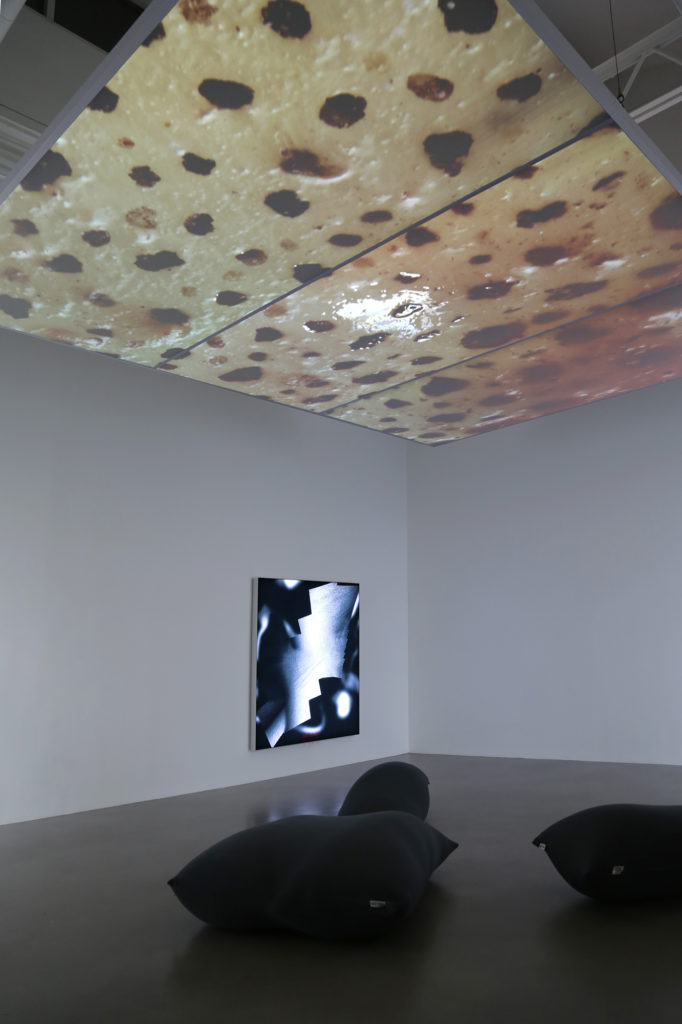
Seth Price, Social Synth (2017). Courtesy of Petzel Gallery.
What do you mean?
A vacuum-formed jacket, or a calendar as a painting, a crumpled piece of mylar, the handbag soft-sculptures made out of Kevlar. There’s a dumbness to those forms. They’re about material, and about inhabiting different feelings, and realms of production, and experimentation. I’m happy with the kind of discourse they might produce, but sometimes it can be enough to say, “This thing is weird.”
Weirdness seems like a dubious achievement for an artwork, no? Playing devil’s advocate, I might say that anyone can make weird.
I don’t think it’s that easy. If that were true, we’d be living in an amazing, liberated world where everyone could be as freaky as they want. But maybe you and I have different definitions of weird.
I’ve noticed that people often talk about your work with a sense of hesitation or even suspicion, as if they weren’t sure of the machinations the artist may or may not have on his audience. This reminds me of people like Bruce Nauman or Richard Prince—two very different artists, sure, but both inspire similar reactions from viewers. It’s like the audience is afraid to be made the butt of some joke. Have you found this to be the case too?
I have. I think it happens when the work is using cultural or social material, and as a viewer you know it must be somehow personal, but at the same time, the artist insists on distance. It makes it hard to know what the stakes are. That’s a kind of power, and if you think about the three artists we’re talking about, it’s much easier for a straight white man to claim that social material, and take some distance, and have the work be allowed to keep its ambiguity. You can risk suspicion of your whole project, like you said, and come out the other side and get taken ultra-seriously. So, whatever else the work is doing, there are times when it probably has a kind of sovereignty, and you feel that as a viewer. I think that’s part of the reaction you’re talking about.
Do you worry that it comes at the expense of the viewer’s appreciation? How do you ride that line?
Art comes out of weird, contradictory forces. I make art for myself, and there’s a small group of people—mostly other artists—that I hope I’m in dialogue with. At the same time, without an audience, it’s annihilated. But I can’t let myself go there, because what people think about the work is potentially so important that if I worry about it, I’ll get too distracted to do anything. I need a degree of distance to maintain focus. Sometimes that distance is just a story you tell yourself, but stories are useful, too. It goes deep quickly, doesn’t it? Maybe I should get back to you after ten years of therapy. Honestly, I’m just grateful that a lot of other people appreciate what I do.
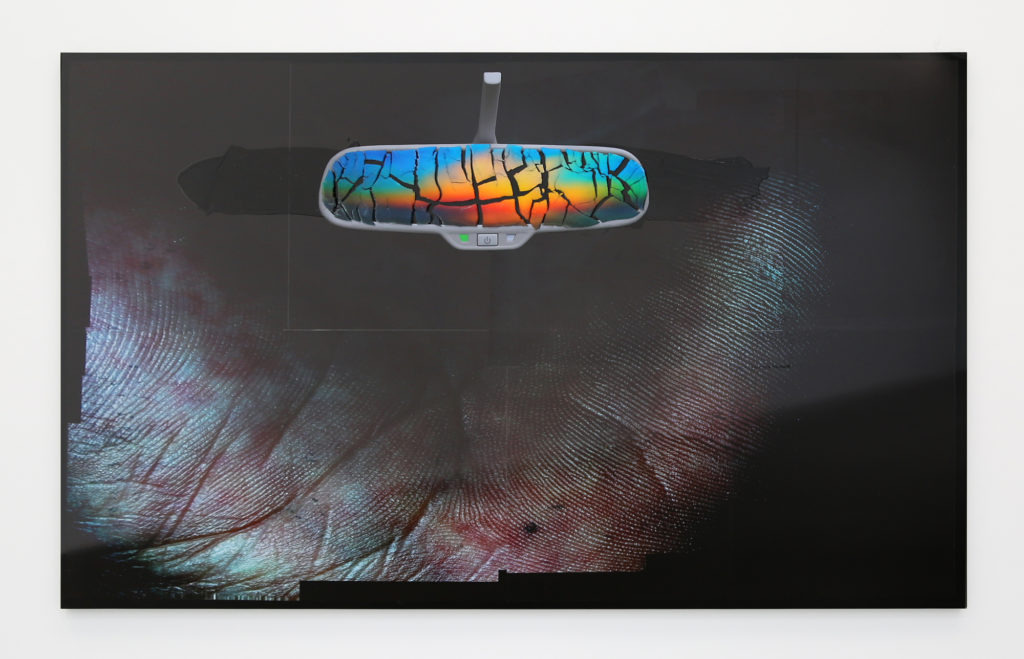
Seth Price, Untitled (2018). Courtesy of Petzel Gallery.
“Hell Has Everything” is on view at Petzel Gallery through January 5, 2018.